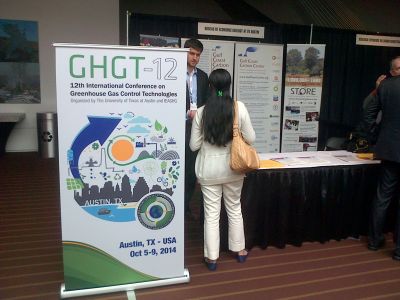 The twelfth annual Carbon Capture Utilization and Sequestration Conference was held again in Pittsburgh over 13-16 May. It was opened by Anthony Cugini Director NETL and the Honourable Brad Wall, Premier of Saskatchewan, and its timing was just after the news that the atmosphere had reached 400 ppm of CO2. These openers were followed by IEAGHG's John Gale, who emphasised this 400ppm point as the prompt for more urgent action, and discussed whether CO2 utilisation was a game-changer or distraction in the context of the net emissions reductions required. This was followed by lots of great updates on North American projects, operating, being built, and being planned. In subsequent plenaries updates were also heard from the UK, EU, Norway, and Australia.
The twelfth annual Carbon Capture Utilization and Sequestration Conference was held again in Pittsburgh over 13-16 May. It was opened by Anthony Cugini Director NETL and the Honourable Brad Wall, Premier of Saskatchewan, and its timing was just after the news that the atmosphere had reached 400 ppm of CO2. These openers were followed by IEAGHG's John Gale, who emphasised this 400ppm point as the prompt for more urgent action, and discussed whether CO2 utilisation was a game-changer or distraction in the context of the net emissions reductions required. This was followed by lots of great updates on North American projects, operating, being built, and being planned. In subsequent plenaries updates were also heard from the UK, EU, Norway, and Australia.
The five hundred plus attendees were treated to two afternoons of six parallel sessions of technical presentations covering all aspects of CCUS, as well as two good sessions of posters, all of which provided a lot of new information!
IEAGHG work was presented not just in the plenary. Tim Dixon and Millie Basava-Reddi gave four other presentations, and two contractors presented IEAGHG-commissioned work. The presentations covered work on Subsurface Resource Interactions with CO2 Storage, Induced Seismicity and CCS, Improving Leakage Monitoring Protocols with New Monitoring Techniques, and Transboundary Regulatory Developments. These presentations can be seen by IEAGHG members on http://www.ieaghg.org/index.php?/20100106145/iea-ghg-presentations.html . In addition, ICF presented the IEAGHG-commissioned work on Financial Mechanisms for Liability, and ARI presented the IEAGHG-commissioned work on Implications of Gas Production from Shales and Coal for CO2 Geological Storage. This was one of a number of presentations on this topic, and may be the first time potential storage capacities for CO2 in gas shales are being estimated and presented. From the ARI work for IEAGHG these are up to 740GT CO2 globally, with 249 GT in North America, this is in the same order as in storage related to CO2-EOR, and therefore suggests this area warrants further attention.
The conference concluded with a discussion panel on CO2 utilisation in the USA, with many good and up-to-date points made by all, including on the life cycle emissions from CO2-EOR, and the hjosir demand for CO2 for use in oil recovery. The final talk was from the Californian EPA on their emissions trading scheme becoming reality and their intentions on CCS fitting into it.
An excellent conference with a North American emphasis and lots of new information, including the seven presentations from IEAGHG. And with 400ppm being reached, there appeared to be a renewed focus on the need for CCUS to actually reduce emissions, so will it become CCuS?
 The University of Texas at Austin Stand at Pittsburgh Conference
The University of Texas at Austin Stand at Pittsburgh Conference
Tim Dixon and Millie Basava-Reddi


